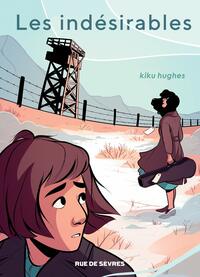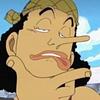Take a photo of a barcode or cover
During Kiku’s vacation in San Francisco, she finds herself displace and transported by to a history that was previously unknown to her -- a 1940s Japanese-American internment camp where her grandma found herself placed in WW2. Through the landscape and imagery Kiku learns about camp life, loyalty tests, and the reluctance / erasure to embrace Japanese culture because of this ingrained trauma. Kiku, who is biracial, slowly reconnects with her family history while also exploring the topics of ‘model minority’ and her heritage. Overall, these illustrations and story captures the intergenerational trauma and history during this period.
emotional
informative
reflective
medium-paced
Plot or Character Driven:
A mix
Strong character development:
Yes
Diverse cast of characters:
Yes
fast-paced
I stole this graphic novel from my 11 year old's school library pile and read it in an evening, and it it is a wonderfully told story based on Hughes' grandparents story of being sent to Japanese internment camps after WWII. The way she presents the harsh realities of this often overlooked piece of history is perfect for young readers, as the main character in present day is transported back in time and swept up into this terrible situation, forcing one to put themselves in the shoes of those who lost so much.
emotional
informative
reflective
medium-paced
Plot or Character Driven:
A mix
Strong character development:
Yes
Loveable characters:
Yes
Diverse cast of characters:
Yes
Flaws of characters a main focus:
Complicated
Stories about intergenerational history and trauma and memories always fuck me up bad
Kiku keeps being pulled back in time. Back to the Japanese Incarceration camps of WWII, where her grandmother and great-grandmother are held. She begins to learn about her history, and learn about what was lost.
This is a beautiful graphic novel depiction of Japanese Incarceration camps, that draws on real people and historic artifacts to piece together a very human picture of what life was like in the camps. The magical realism of time-travel through memory feels authentic - I was worried it might feel a bit awkward. I love how the author connects what she learns about the past with how Japanese culture has shifted for many in the Japanese diaspora, and how the events of World War II connect with current events and injustices against immigrants, refugees and others today.
This is a beautiful graphic novel depiction of Japanese Incarceration camps, that draws on real people and historic artifacts to piece together a very human picture of what life was like in the camps. The magical realism of time-travel through memory feels authentic - I was worried it might feel a bit awkward. I love how the author connects what she learns about the past with how Japanese culture has shifted for many in the Japanese diaspora, and how the events of World War II connect with current events and injustices against immigrants, refugees and others today.
I've admired Kiku Hughes's artwork ever since I saw her work featured in an The Lost Adventures & Team Avatar Tales, so I was excited to pick up her first solo outing.
There was a really interesting interplay of reality, history, and fantasy here, and Hughes did a great job of using the contemporary lens to frame the internment camps and show the startling parallels to current policy. The comparison to and inspiration from Octavia Butler's Kindred is very apt. Within that history and all the reader is learning about life in those camps, there's a lot of genuine heart in the friendships Kiku makes and what she's able to learn about herself and her family by interacting with other Japanese Americans. What she saw as a culture being lost or forgotten was really a survival tactic to be able to live as freely as possible during the war and the years beyond.
This is a quick read with lots of depth, and would be a great companion to George Takei's excellent graphic memoir They Called Us Enemy.
There was a really interesting interplay of reality, history, and fantasy here, and Hughes did a great job of using the contemporary lens to frame the internment camps and show the startling parallels to current policy. The comparison to and inspiration from Octavia Butler's Kindred is very apt. Within that history and all the reader is learning about life in those camps, there's a lot of genuine heart in the friendships Kiku makes and what she's able to learn about herself and her family by interacting with other Japanese Americans. What she saw as a culture being lost or forgotten was really a survival tactic to be able to live as freely as possible during the war and the years beyond.
This is a quick read with lots of depth, and would be a great companion to George Takei's excellent graphic memoir They Called Us Enemy.








